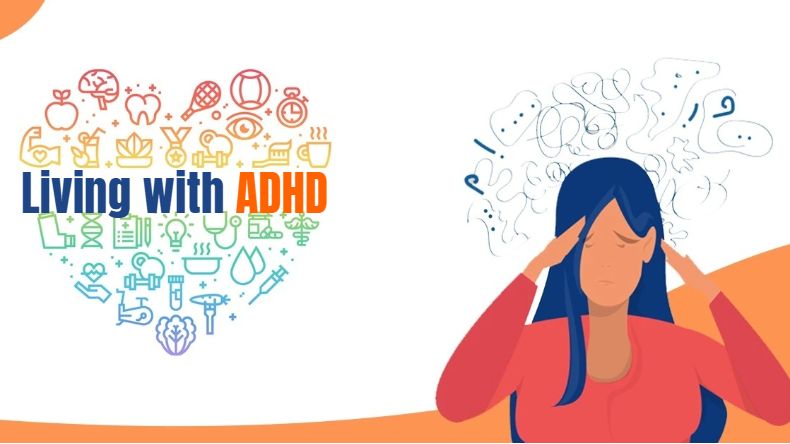
Living with ADHD: Not Just Distraction, But a Different Rhythm
Attention-Deficit/Hyperactivity Disorder (ADHD) is often reduced to stereotypes: the fidgety child, the perpetually late adult, the scatterbrained student. But living with ADHD is a far richer, more complex, and often exhausting experience than mere "distraction".

It's navigating a world seemingly tuned to a different frequency, where the brain operates with both dazzling intensity and frustrating inertia.
Beyond the Fidgeting: The Invisible Currents
The core symptoms – inattention, hyperactivity, impulsivity – manifest in ways outsiders rarely grasp:
The Tyranny of Time:
"Time blindness" isn't laziness. Deadlines vanish into a fog. Five minutes feel like one; an hour feels like five. Planning feels like predicting the weather on Mars. Chronic lateness or frantic last-minute rushes are often painful consequences, not choices.
The Executive Function Fog:
Organizing thoughts, starting tasks, switching gears, managing emotions – these "executive functions" are like a faulty control panel. Simple chores (laundry, bills) can feel like climbing Everest. Decision paralysis is real and debilitating.
The Emotional Rollercoaster:
Rejection Sensitive Dysphoria (RSD) means perceived criticism or failure hits with crushing intensity. Emotions can surge like tidal waves – intense joy, frustration, or sadness – often disproportionate to the trigger and hard to regulate.
Hyperfocus: The Double-Edged Sword:
When passion ignites, ADHD brains can achieve laser-like focus, losing hours (or days) in deep immersion. This "superpower" feels amazing but can derail responsibilities and relationships when it latches onto the "wrong" thing.
The Sensory Avalanche:
Many with ADHD experience heightened or dampened sensitivity. Fluorescent lights hum, tags itch unbearably, background chatter becomes a roar, or conversely, they might crave intense sensory input just to feel grounded.
The Social Maze: Misunderstandings and Masking
Living with ADHD often involves constant navigation of social misunderstandings:
-
Interrupting: Not rudeness, but a desperate fear the brilliant thought will vanish forever if not voiced now.
-
Forgetting Appointments/Names: Not indifference, but a brain struggling to encode and retrieve mundane details amidst its internal whirlwind.
-
Zoning Out: Not boredom, but an overwhelmed brain hitting pause or latching onto an internal thought thread.
-
Impulsive Remarks/Actions: Not malice, but a delayed or bypassed internal "pause button".
-
The Exhaustion of Masking: Many develop sophisticated coping mechanisms to appear "neurotypical" – forcing focus, suppressing fidgets, meticulously tracking time. This constant performance is profoundly draining.
Finding Rhythm: Strategies, Not Cures
Living well with ADHD isn't about becoming "normal". It's about finding strategies to harmonize with your unique brain:
1. Structure is Your Scaffolding:
Rigid routines, visual calendars (paper and digital!), alarms for everything, designated spots for essentials (keys, wallet). Externalize what the brain struggles to hold internally.
2. Break the Monolith:
Large tasks are paralyzing. Break everything into microscopic, actionable steps. "Clean kitchen" becomes "put dishes in dishwasher", then "wipe counter".
3. Body Doubling:
Working alongside someone (even silently online) can provide the external anchor needed to initiate and sustain focus on mundane tasks.
4. Embrace Movement:
Physical activity isn't a luxury; it's essential regulation. Fidget tools, walking meetings, or scheduled movement breaks help channel restless energy and improve focus.
5. Radical Self-Acceptance & Advocacy:
Understand your brain. Forgive the "ADHD tax" (late fees, forgotten items). Communicate needs clearly to partners, friends, employers, and educators. Seek accommodations (noise-canceling headphones, flexible deadlines, written instructions).
6. Seek Your Tribe:
Connect with other neurodivergent individuals. Sharing experiences reduces isolation and provides invaluable practical tips and emotional support.
7. Professional Support:
Therapy (especially ADHD-focused CBT or DBT) and, if appropriate and helpful, medication can be crucial tools in managing symptoms and building coping skills.
The Flip Side: The ADHD Spark
While challenging, the ADHD brain possesses remarkable strengths:
-
Creativity & Innovation: Making unexpected connections, thinking outside rigid boxes.
-
Resilience: Navigating constant challenges builds remarkable adaptability and problem-solving skills.
-
Hyperfocus & Passion: Unparalleled drive and depth in areas of genuine interest.
-
Energy & Enthusiasm: Infectious zest for life and new ideas when engaged.
-
Empathy & Intuition: Often highly attuned to others' emotions and non-verbal cues.
Conclusion: A Different Operating System
Living with ADHD is not a character flaw. It's a neurologically different way of experiencing the world – a brain wired for exploration, intensity, and rapid connection, often struggling with the mundane structures society demands. It requires self-compassion, tailored strategies, understanding from others, and a recognition of the unique strengths that come with this different rhythm. It's about learning to dance to your own beat, even when the world seems to be playing a different tune. The journey isn't easy, but embracing the neurodivergence can lead to a vibrant, authentic, and deeply meaningful life.